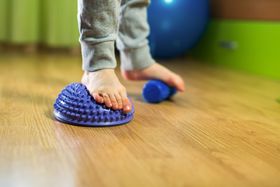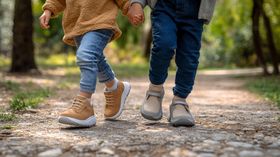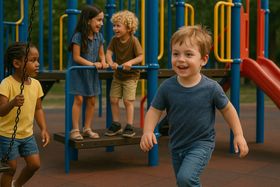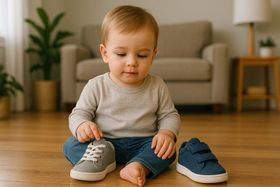Bow Legs in Babies: Correcting With Care at Home
Most babies are born with bowed legs due to their curled position in the womb—this is completely normal. The bowing typically straightens naturally as your child grows and begins walking, usually by age 2-3, with no treatment needed.
Published October 11, 2025
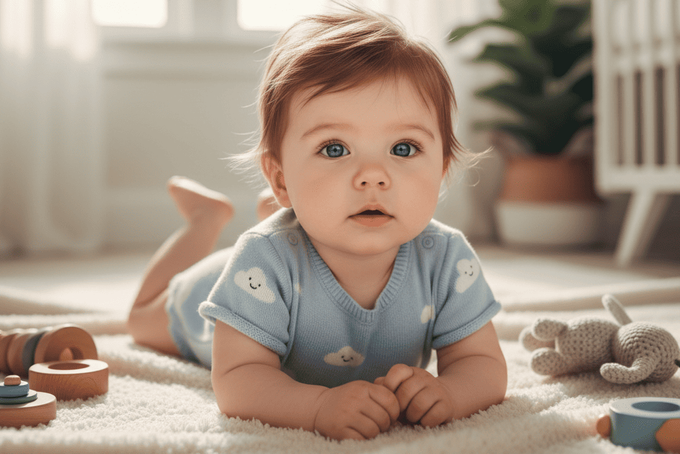
You're changing your baby's diaper when you notice their legs curve outward. You may ask other moms, who suggest special shoes or exercises to "fix" the problem.
Now, before you worry or try any corrections for bowed legs, here's what you need to know: bowed legs in babies are almost always completely normal. They're actually an expected part of infant development that resolves on its own.
Let's talk about why your baby's legs look bowed, when this is normal, and the rare situations when you should talk to your pediatrician.
What Causes Bow Legs In Babies
Think about where your baby spent the last nine months—curled up like a pretzel in a pretty cosy space. Their legs stayed folded and bent because there simply wasn't room to stretch out fully [1]. Their legs moved less than other body parts, which is why babies are born with that curved shape.
This is your baby's body showing evidence of where they've been, not a problem that needs fixing.
You might notice some differences around 6 months as your baby's motor skills develop and their bowlegs start to straighten. The real changes happen between ages 1-3 when your child bears weight through standing and walking. Their legs naturally correct themselves through normal movement and growth.
Something I noticed that surprises many parents is that some toddlers develop knock-knees after the bow-legged phase, where their legs are straight but their inner knees touch.
This happens more often in children who walk before their first birthday. Don't worry, though, as this phase also resolves on its own by age 6-7.
When Bow Legs In Babies Are a Normal Development
Your baby's bow legs are perfectly normal when both legs look similarly curved and are growing at the same rate. The bowing gradually gets better as they grow, and you won't notice any limping or trouble with movement. Your child hits their motor and foot development milestones right on schedule.
Specifically, bow legs are normal if the curve measures 15 degrees or less, both legs have the same shape, and you're seeing gradual improvement over the months.
If this describes your baby's situation, there's genuinely nothing to worry about. The straightening will continue naturally as your child becomes more active.
When Bow Legs In Children Need Medical Evaluation
While most bow legs are just fine, certain signs mean it's time to ring your paediatrician [2]:
- One leg is more bowed than the other. If only one leg curves significantly or one seems to be growing differently, that needs evaluation. Normal bowing affects both legs equally.
- The bowing looks severe. If the curve seems excessive or your baby stands on the outer edges of their feet because of the bowing, mention this at your next visit. Paediatricians use 15 degrees as the upper limit of normal—anything beyond that warrants a closer look.
- Bow legs stick around past age 6. Most bowing resolves by ages 2-3. If your child's legs remain noticeably bowed past age 6, or if bowing develops in an older child who previously had straight legs, this needs assessment.
- Your baby has trouble with movement. If your baby seems to struggle bearing weight on their legs, shows delays in crawling, walking with an abnormal gait, or has any limp, discuss this with your paediatrician.
Medical Conditions Causing Bow Legs In Children
In rare cases, bow legs can signal an underlying condition. These are uncommon, and your paediatrician monitors for them during regular well-child visits.
- Blount's disease affects the growth plate in the lower leg bone (tibia). When the inner side of this growth plate doesn't work properly, only the outer side grows, creating a bowed shape. This can happen in one or both legs. Early walking and family history increase the risk in young children [3].
- Rickets is a group of disorders where bones become fragile due to insufficient calcium, phosphorus, or vitamin D. Without these essential nutrients, the bones in your child's arms, legs, and fingers develop abnormal shapes. Symptoms typically show up between 6 months and 2 years [4].
- Neurofibromatosis type I can also cause congenital bowed legs if leg bones are affected by fibrous tissue tumours, which may also create differences in leg length [5].
Expert Note: These conditions look different from normal bow legs and are very rare. Normal bowing is symmetrical, gradually improves, doesn't cause limping or walking problems, and doesn't interfere with your child hitting their developmental milestones.
How to Support Leg Development In Babies With Bow Legs
You can support your baby's natural leg development without trying to "fix" anything.
1. Give Your Baby Plenty of Tummy Time to Support Bow Legs
Start tummy time after the umbilical stump falls off, as early as two weeks old. If your baby resists at first, try just one minute during each nappy change—this adds up to lots of practice throughout the day.
Place toys or a mirror at eye level to encourage arm movements and leg kicking. By 4-6 months, babies use their legs to rotate their bodies while on their bellies. This strengthens legs naturally and encourages crawling.
2. Practise Upright Weight Bearing to Support Bow Legs
Around three months, your baby should be able to flatten their feet and support their body weight while you hold them standing. Many parents worry that this harms developing legs or backs, but it actually helps strengthen legs for future motor skills.
This weight-bearing practice benefits development and won't worsen bowing. In fact, bearing weight is like an exercise that helps strengthen feet and helps legs develop a straighter appearance over time.
3. Ensure Proper Vitamin D Intake to Support Bow Legs
Vitamin D helps maintain a balance of calcium and phosphorus in your baby's body, supporting healthy bone development. If you're breastfeeding, your baby needs a vitamin D supplement—400 IU daily until 12 months, then 600 IU until age 2.
Formula-fed babies get sufficient vitamin D from infant formula. Once your baby starts solid foods after 6 months, fortified cereals, fish, and eggs provide additional vitamin D [6].
Expert Note: This is particularly important if you experienced vitamin D or nutritional deficiencies during pregnancy, as this can increase your baby's risk of rickets or poor bone development.
What Doesn't Help Bow Legs In Babies
- Special Shoes or Braces: Devices and corrective shoes don’t speed up natural straightening—normal bow legs self-correct
- Massages: Bowing relates to bone shape, not muscles, so massage has no effect
- Walkers: They don’t cause or fix bow legs and may pose injury risks
- Sleep Positions: Changing how your baby sleeps won’t alter leg shape; focus on safe sleep practices
When Your Paediatrician May Refer You To A Specialist
Your paediatrician may refer your baby to a paediatric orthopaedist if bowing is greater than 15 degrees, one leg looks longer, hip dysplasia is present, or motor skills are affected.
The specialist evaluation may include X-rays and, if needed, non-surgical or surgical treatment.
Note that referrals for these issues are uncommon because most bow legs are normal. Early intervention for genuine problems leads to better outcomes, which is why your paediatrician monitors leg development at every well-child visit.
Supporting Normal Development In Babies With Bow Legs
Bowed legs in babies are usually a normal part of development, caused by their curled position in the womb. They improve naturally as your child grows and becomes more active.
Special treatments, exercises, or shoes aren’t necessary for normal bowing—regular pediatric check-ups, tummy time, movement, and proper nutrition (including vitamin D) are what your baby needs.
As your baby reaches walking milestones, proper footwear helps support healthy foot development. First Walkers orthopedic shoes provide the right support for growing feet without affecting natural leg alignment, giving parents peace of mind while encouraging safe, confident steps.
References
Bow legged. (2025, September 12). Cleveland Clinic. https://my.clevelandclinic.org/health/diseases/22049-bow-legged
Bowlegs | Boston Children’s Hospital. (n.d.). https://www.childrenshospital.org/conditions/bowlegs
Blount’s Disease. (2025, September 24). Cleveland Clinic. https://my.clevelandclinic.org/health/diseases/22424-blounts-disease
Rickets. (2025, June 2). Cleveland Clinic. https://my.clevelandclinic.org/health/diseases/22459-rickets
Neurofibromatosis type 1 - Symptoms and causes. (n.d.). Mayo Clinic. https://www.mayoclinic.org/diseases-conditions/neurofibromatosis-type-1/symptoms-causes/syc-20350490
Vitamin D and breastfeeding. (2025, September 23). Breastfeeding Special Circumstances. https://www.cdc.gov/breastfeeding-special-circumstances/hcp/diet-micronutrients/vitamin-d.html
Disclaimer: First Walkers' information is intended for educational and informational purposes related to toddler footwear and feet. We encourage you to consider individual circumstances and consult qualified orthopaedists about specific conditions.
FAQs
Are bow legs in babies normal?
Yes, bow legs are completely normal in babies and young toddlers. They're caused by your baby's curled position in the womb and typically straighten naturally by age 2-3 as your child grows and begins walking.
How do I know if my baby's bow legs are normal?
Normal bow legs affect both legs similarly (symmetrical), measure 15 degrees or less, and gradually improve over time. Your baby should have no difficulty with movement and should be meeting motor milestones as expected.
Can I fix my baby's bow legs with exercises?
No exercises or treatments are needed or recommended for normal bow legs. The bowing resolves naturally as your baby grows. Activities like tummy time and weight-bearing practice support overall development but won't speed up leg straightening.
Do bow legs cause problems later in life?
Normal bow legs that resolve naturally don't cause problems later in life. However, persistent bowing or bowing caused by underlying medical conditions may require treatment to prevent long-term complications.


